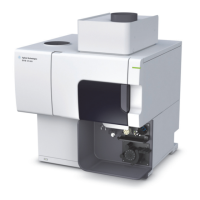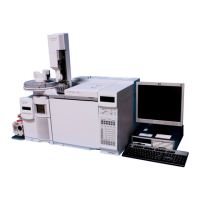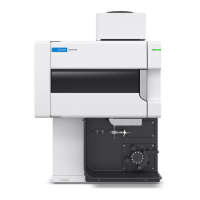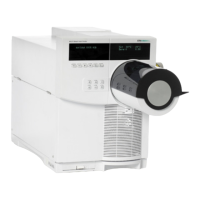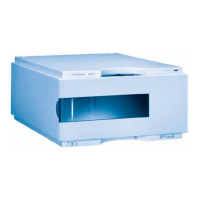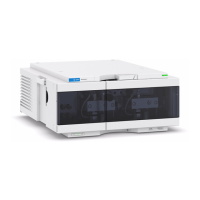Agilent 5110/5100 ICP-OES Service Manual Agilent Restricted 53
3 General Information
Polychromator assembly
The Polychromator and pre optics are purged to allow Spectral analysis at low UV wavelengths
aswell as to protect the Camera from moisture damage. The purge gas enters through a fitting
mounted on the top of the polychromator casting and purges the polychromator and also enters
the pre-optics casting to purge the snout and cone.
Shutter
For the Agilent 5110 ICP-OES instruments, the collected incident light from the pre-optics
assembly passes through a mechanical shutter. This shutter is solenoid driven and controlled
through the camera control board.
The shutter is used to stop the transfer of light from the plasma into the polychromator when
calculating camera dark current and establishing camera electronic noise offsets.
When closed the shutter reduces the exposure of the pilot mirror to UV energy created by the
plasma. Over time the UV energy may cause discoloration of the pilot mirror surface coating. By
closing the shutter when measurements are not being made, the effects of the UV energy are
reduced.
Pilot mirror
The pilot mirror assembly consists of a flat pilot mirror mounted on a bracket designed
specifically for the polychromator. The pilot mirror is used to transfer the converging light from
the pre-optics assembly to the entrance slit.
Entrance slit
The entrance slit of the polychromator is in the shape of a parallelogram. The slit is positioned
15 degrees off center axis. The slit allows for a parallelogram shaped image at the plasma that
is 0.029 mm high and 0.051 mm wide.
Collimating mirror
Collimating mirror (M6) is an off axis parabolic mirror. The geometry of the mirror is used to
reduce spherical aberrations. The mirror is made from aluminum, and coated with MgF
2
to
enhance transmission of ultra violet energy. The reflective surface is masked down to reduce
stray light and to set the entrance aperture.
There are no field alignment adjustments for this collimator mirror.
Prism
The cross-dispersing prism and echelle grating are mounted on a single assembly. The
assembly consists of a casting on which the grating and prism are mounted in fixed positions.
The prism is mounted in a bracket that is screwed on to the grating casting. A baffle that
reduces stray light surrounds the prism, prism mount and face of the grating.
The light from mirror M6 passes through the prism and on to the grating. The refracted light of
the prism is then diffracted by the grating and passed through the prism again.
The prism refracts light in the horizontal axis across the focal plane.
Grating
The grating is an aluminium echelle ruled grating that is replicated on a fused silica plate. It has
a groove density of 94.74 grooves / mm at a blaze angle of 44.77°.

